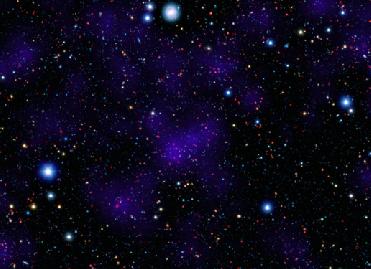
This composite image combining infrared and visible-light observations shows the CLG J02182-05102 galaxy cluster containing several red, hot , massive galaxies. A NASA photo
WASHINGTON (BNS): A most distant, primitive galaxy cluster dating back to 9.6 billion years ago has been unearthed by a team of astronomers studying early Universe.
The old galaxy cluster containing red, hot, massive galaxies, however, appears quite young and modern in its look. The cluster is similar to a young version of the 'Coma Cluster' of today, which has had billions of more years to develop, according to NASA.
The CLG J02182-05102 galaxy cluster has been spotted by NASA's Spitzer Space Telescope. The cluster's age and size, as estimated by the researchers, makes it an aberration when compared to its other same-age peers which are much smaller and presumably take billions of more years to collect enough galaxies to reach such a size.
“We are seeing something already aged and red like a younger version of the Coma Cluster from a distant, bygone era.”
“It is as though we dug an archeological site in Rome and found pieces of modern Rome in amongst the ruins,” said Casey Papovich, lead author of the new study which appears in the April issue of Astrophysical Journal.
As per the researchers’ estimation, there are around 60 galaxies in CLG J02182-05102.
Galaxy clusters are the largest gravitationally bound structures in the Universe and are thought to have formed piecemeal over cosmic time. For now, ClG J02182-05102 is the only known galactic grouping so far away in the past.
Whether CLG J02182-05102 fully qualifies as a gravitationally bound cluster will rely on further observations.
 Previous Article
Previous Article Next Article
Next Article











The Indian Air Force, in its flight trials evaluation report submitted before the Defence Ministry l..
view articleAn insight into the Medium Multi-Role Combat Aircraft competition...
view articleSky enthusiasts can now spot the International Space Station (ISS) commanded by Indian-American astr..
view article